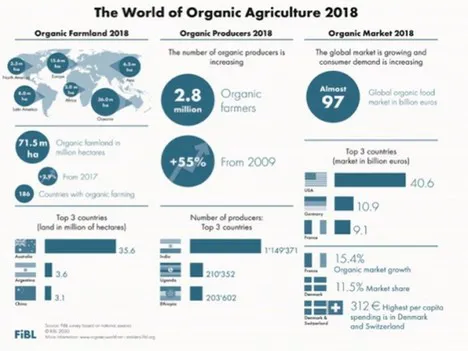2018 was another record year for global organic agriculture. According to the latest FiBL survey on organic agriculture worldwide, organic farmland increased by 2.0 million hectares, and organic retail sales also continued to grow, reaching another all-time high, as shown by the data from 186 countries (data as of the end 2018). The 21st edition of the study “The World of Organic Agriculture” published by FiBL and IFOAM – Organics International shows a continuation of the positive trend seen in the past years. This annual survey on organic agriculture worldwide is supported by the Swiss State Secretariat for Economic Affairs (SECO), the International Trade Centre (ITC), the Sustainability Fund of Coop Switzerland, and NürnbergMesse, the organizers of the BIOFACH fair.

Continued growth
The market research company, Ecovia Intelligence, estimates that the global market for organic food surpassed 100 billion US dollars for the first time in 2018 (almost 97 billion euros). The United States is the leading market with 40.6 billion euros, followed by Germany (10.9 billion euros) and France (9.1 billion euros). In 2018, many major markets continued to show double-digit growth rates, and the French organic market grew by more than 15 percent. Danish and Swiss consumers spent the most on organic food (312 Euros per capita in 2018). Denmark had the highest organic market share with 11.5 percent of its total food market.
In 2018, 2.8 million organic producers were reported. India continues to be the country with the highest number of producers (1,149,000), followed by Uganda (210,000), and Ethiopia (204,000).
Steady increase of organic farmland
A total of 71.5 million hectares were organically managed at the end of 2018, representing a growth of 2.9 percent or 2 million hectares compared to 2017. Australia has the largest organic agricultural area (35.7 million hectares), followed by Argentina (3.6 million hectares), and China (3.1 million hectares). Due to the large area of organic farmland in Australia, half of the global organic agricultural land is in Oceania (36.0 million hectares). Europe has the second largest area (15.6 million hectares), followed by Latin America (8 million hectares). The organic area increased in all continents compared to 2017.
Globally, 1.5 percent of farmland is organic. However, many countries have far higher shares. The countries with the largest organic share of their total farmland are Liechtenstein (38.5 percent), Samoa (34.5 percent), and Austria (24.7 percent). In sixteen countries, 10 percent or more of all agricultural land is organic.
For more information: 
Dr. Helga Willer
FiBL
Tel: +41 (0)79 218 06 26
Email: helga.willer@fibl.org
www.fibl.org
